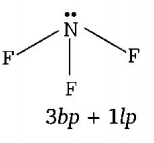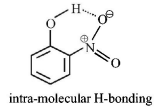241. Which of the following are arranged in an increasing order of their bond strengths?
A
$$\,O_2^ - < {O_2} < O_2^ + < O_2^{2 - }$$
B
$$O_2^{2 - } < O_2^ - < {O_2} < O_2^ + $$
C
$$\,O_2^ - < O_2^{2 - } < {O_2} < O_2^ + $$
D
$$O_2^ + < {O_2} < O_2^ - < O_2^{2 - }$$
Answer :
$$O_2^{2 - } < O_2^ - < {O_2} < O_2^ + $$
242. In which of the following sets, all the given species are isostructural ?
A
$$C{O_2},N{O_2},Cl{O_2},Si{O_2}$$
B
$$PC{l_3},Al\,C{l_3},BC{l_3},SbC{l_3}$$
C
$$B{F_3},N{F_3},P{F_3},Al\,{F_3}$$
D
$$BF_4^ - ,CC{l_4},NH_4^ + ,PCl_4^ + $$
Answer :
$$BF_4^ - ,CC{l_4},NH_4^ + ,PCl_4^ + $$
243. The species having bond order different from that in $$CO$$ IS
A
$$N{O^ - }$$
B
$$N{O^{ + \,\,}}$$
C
$$C{N^ - }$$
D
$${N_2}$$
Answer :
$$N{O^ - }$$
244. Which of the following statements is incorrect ?
A
$$N{H_3}$$ is more basic than $$P{H_3}.$$
B
$$N{H_3}$$ has a higher boiling point than that of $$HF.$$
C
$${N_2}$$ is less reactive than $${P_4}.$$
D
The dipole moment of $$N{H_3}$$ is less than that of $$S{O_2}.$$
Answer :
$$N{H_3}$$ has a higher boiling point than that of $$HF.$$
245. Specify the coordination geometry around and hybridisation of $$N$$ and $$B$$ atoms in a $$1:1$$ complex of $$B{F_3}$$ and $$N{H_3}$$
A
$$N:$$ tetrahedral, $$s{p^3};B:$$ tetrahedral, $$s{p^3}$$
B
$$N:$$ pyramidal, $$s{p^3};B:$$ pyramidal, $$s{p^3}$$
C
$$N:$$ pyramidal, $$s{p^3};B:$$ planar, $$s{p^2}\,$$
D
$$N:$$ pyramidal, $$s{p^3};B:$$ tetrahedral, $$s{p^3}$$
Answer :
$$N:$$ tetrahedral, $$s{p^3};B:$$ tetrahedral, $$s{p^3}$$
246. Which one among the following does not have the hydrogen bond?
A
phenol
B
liquid $$N{H_3}$$
C
water
D
liquid $$HCl$$
Answer :
liquid $$HCl$$
247. In which of the following molecules are all the bonds not equal?
A
$$Cl{F_3}$$
B
$$B{F_3}$$
C
$$Al{F_3}$$
D
$$N{F_3}$$
Answer :
$$Cl{F_3}$$
248. The weakest among the following types of bond is
A
ionic
B
covalent
C
metallic
D
$$H$$-bond
Answer :
$$H$$-bond
249. Ortho-Nitrophenol is less soluble in water than $$p{\text{ - }}$$ and $$m{\text{ - }}$$ Nitrophenols because :
A
$$o{\text{ - }}$$Nitrophenol is more volatile steam than those of
$$m{\text{ - }}$$ and $$p{\text{ - }}$$isomers.
B
$$o{\text{ - }}$$Nitrophenol shows intramolecular $$H$$ - bonding
C
$$o{\text{ - }}$$Nitrophenol shows intermolecular $$H$$ - bonding
D
Melting point of $$o{\text{ - }}$$Nitrophenol is lower than those of $$m{\text{ - }}$$ and $$p{\text{ - }}$$isomers.
Answer :
$$o{\text{ - }}$$Nitrophenol shows intramolecular $$H$$ - bonding
250. In which of the following molecules/ions $$B{F_3},NO_2^ - ,NH_2^ - \,{\text{and}}\,{H_2}O,$$ the central atom is $$s{p^2}$$ hybridised?
A
$$NO_2^ - \,{\text{and}}\,NH_2^ - $$
B
$$NH_2^ - \,{\text{and}}\,{H_2}O$$
C
$$NO_2^ - \,{\text{and}}\,{H_2}O$$
D
$$B{F_3}\,{\text{and}}\,NO_2^ - $$
Answer :
$$B{F_3}\,{\text{and}}\,NO_2^ - $$




 $$ \Rightarrow 3\sigma $$ - bonds, i.e. $$s{p^2}$$ hybridisation
$$ \Rightarrow 3\sigma $$ - bonds, i.e. $$s{p^2}$$ hybridisation  $$ \Rightarrow 2\sigma $$ - bonds $$+1$$ lone pair of
electrons, i.e. $$s{p^2}$$ hybridisation
$$ \Rightarrow 2\sigma $$ - bonds $$+1$$ lone pair of
electrons, i.e. $$s{p^2}$$ hybridisation  $$ \Rightarrow 2\sigma $$ - bonds $$+2$$ lone pairs, i.e. $$s{p^3}$$ hybridisation
$$ \Rightarrow 2\sigma $$ - bonds $$+2$$ lone pairs, i.e. $$s{p^3}$$ hybridisation 